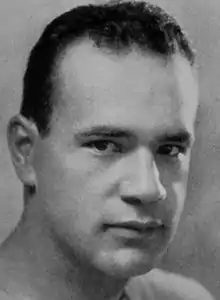 | |
| Biographical details | |
|---|---|
| Born | June 14, 1898 Jeffersonville, Indiana, U.S. |
| Died | June 2, 1943 (aged 44) Los Gatos, California, U.S. |
| Playing career | |
| 1916–1918 | Navy |
| Coaching career (HC unless noted) | |
| 1922 | William & Mary |
| 1923–1925 | Indiana |
| 1926–1930 | Navy |
| 1931–1934 | California |
| Head coaching record | |
| Overall | 75–42–9 |
| Accomplishments and honors | |
| Championships | |
| 1 National (1926) | |
| College Football Hall of Fame Inducted in 1973 (profile) | |
William Austin Ingram (June 14, 1898 – June 2, 1943) was an American college football player and coach. He served as the head football coach at The College of William & Mary (1922), Indiana University (1923–1925), the United States Naval Academy (1926–1930), and the University of California, Berkeley (1931–1934), compiling a career record of 75–42–9. Ingram's 1926 Navy team went 9–0–1 and was recognized as a national champion by the Boand System and the Houlgate System. Ingram was also known by the nickname "Navy Bill", due to his background at Annapolis.[1] He was inducted into the College Football Hall of Fame as a coach in 1973, and he died in his sleep while serving as a Major in the Marine Corps.[2]
Coaching career
From 1923 to 1925, he guided Indiana to a 10–12–1 record. At Navy he posted a 32–13–4 record. These totals included his 1926 team, which finished with a 9–0–1 record. He coached at California and won 27 games in four years. During the 1934 West Coast waterfront strike, Ingram organized his Cal players to work as strikebreakers.[1]
Head coaching record
| Year | Team | Overall | Conference | Standing | Bowl/playoffs | ||||
|---|---|---|---|---|---|---|---|---|---|
| William & Mary Indians (Independent) (1922) | |||||||||
| 1922 | William & Mary | 6–3 | |||||||
| William & Mary: | 6–3 | ||||||||
| Indiana Hoosiers (Big Ten Conference) (1923–1925) | |||||||||
| 1923 | Indiana | 3–4 | 2–2 | T–5th | |||||
| 1924 | Indiana | 4–4 | 1–3 | 7th | |||||
| 1925 | Indiana | 3–4–1 | 0–3–1 | T–9th | |||||
| Indiana: | 10–12–1 | 3–8–1 | |||||||
| Navy Midshipmen (Independent) (1926–1930) | |||||||||
| 1926 | Navy | 9–0–1 | |||||||
| 1927 | Navy | 6–3 | |||||||
| 1928 | Navy | 5–3–1 | |||||||
| 1929 | Navy | 6–2–2 | |||||||
| 1930 | Navy | 6–5 | |||||||
| Navy: | 32–13–4 | ||||||||
| California Golden Bears (Pacific Coast Conference) (1931–1934) | |||||||||
| 1931 | California | 8–2 | 4–1 | 2nd | |||||
| 1932 | California | 7–3–2 | 2–2–1 | T–5th | |||||
| 1933 | California | 6–3–2 | 2–2–2 | 6th | |||||
| 1934 | California | 6–6 | 3–2 | 5th | |||||
| California: | 27–14–4 | 11–7–3 | |||||||
| Total: | 75–42–9 | ||||||||
| National championship Conference title Conference division title or championship game berth | |||||||||
References
- 1 2 Hochschild, Adam (29 March 2016). Spain in Our Hearts: Americans in the Spanish Civil War, 1936-1939. Houghton Mifflin Harcourt. ISBN 9780547973180. p. 8:
At Berkeley, hundreds of professors and students, like Merriman, ferverntly backed the strikers, while the football coach—William Ingram, an Annapolis graduate known as 'Navy Bill'—organized players to work as strikebreakers.
- ↑ "Marine Corps Chevron 5 June 1943 — Historical Periodicals".